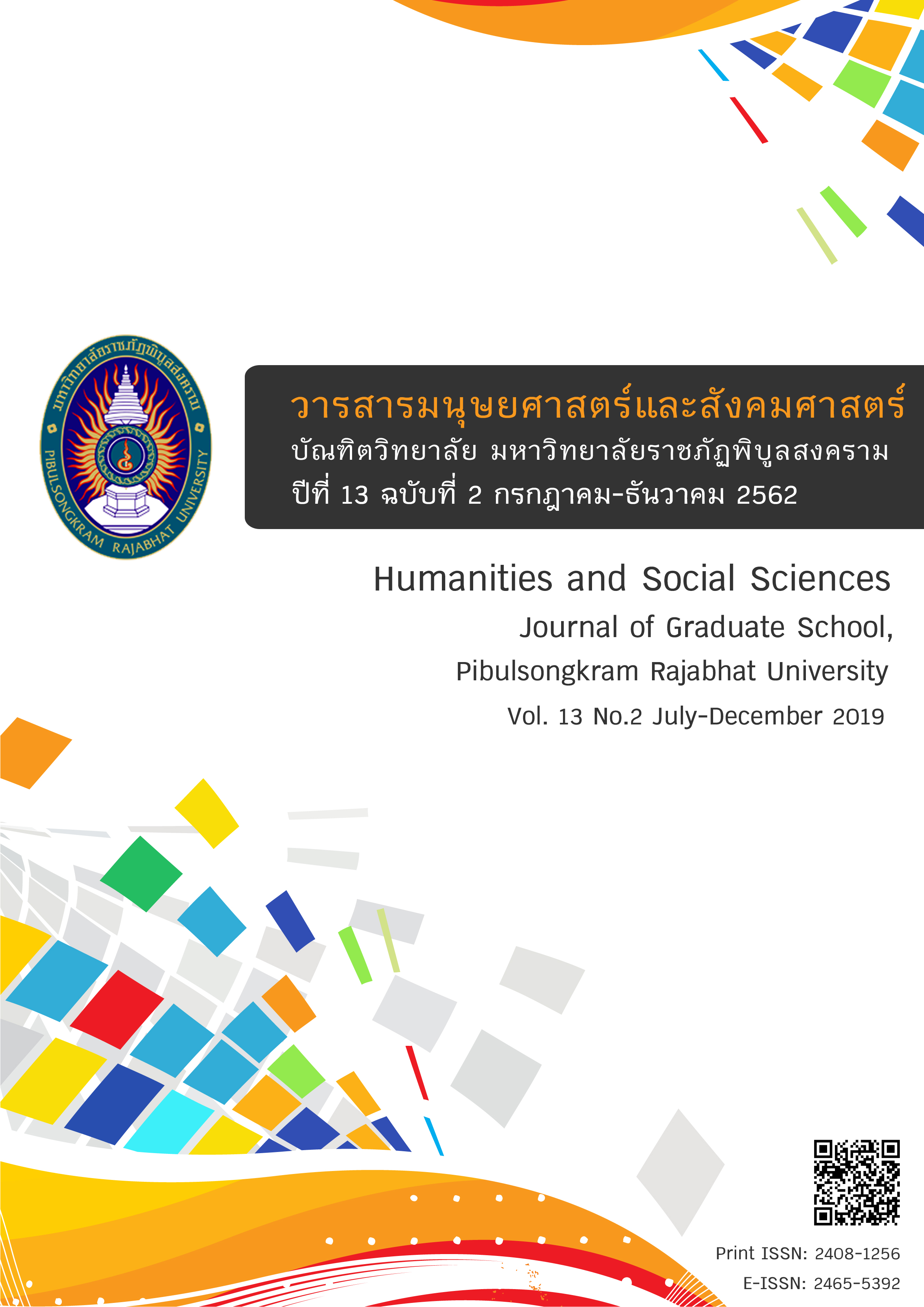The Study of Needs Asessment in the Development of the On-line Examination Management System and the Item Bank to Provide Feedback for Secondary School Students by the Application of Item Response Theory
Keywords:
Needs Assessment, On-line Examination Management, Item Bank, Provide Feedback, Item Response TheoryAbstract
This research aims to study 4 aspects of needs assesment in the development of the On-line Examination Management System and the Item Bank to Provide Feedback for Secondary School Students by the Application of Item Response Theory which are 1) The online examination management system and the item bank program guidebook 2) The online examination management system and the item bank program 3) Providing effective feedback to develop learners 4) The benefits of using the online examination management system and the item bank. The sample group was the group of 285 school directors teachers and supervisors under the Secondary Educational Service Area Office 38-42 by using multi-stage sampling method. The research instrument was a questionnaire containing a mean value between 0.71-1.0 and a reliability value of 0.98. The data analysis was conducted by using Priority Need Index with Modified Needs Indexing technique. The research result found that the needs assesment in the development of the On-line Examination Management System and the Item Bank to Provide Feedback for Secondary School Students by the Application of Item Response Theory could be arranged in descending order as follow: 1. Providing effective feedback to develop learners (PNIModified = 0.67) 2. The online examination management system and the item bank program (PNIModified = 0.64) 3. The benefits of using the online examination management system and the item bank (PNIModified = 0.62) and 4. The online examination management system and the item bank program guidebook (PNIModified = 0.60).
References
กระทรวงศึกษาธิการ. (2552). หลักสูตรแกนกลางการศึกษาขั้นพื้นฐาน พุทธศักราช 2551. กรุงเทพฯ: โรงพิมพ์ชุมนุมสหกรณ์การเกษตรแห่งประเทศไทย.
บุญชม ศรีสะอาด. (2543). การวิจัยทางการวัดผลและประเมินผล. กรุงเทพฯ: สุวีริยาสาส์น.
__________. (2553). การวิจัยเบื้องต้น (พิมพ์ครั้งที่ 8). กรุงเทพฯ: สุวีริยาสาส์น.
วีรภัทร์ สุขศิริ. (2559). การประเมินการเรียนรู้ในศตวรรษที่ 21 : ความเข้าใจที่คลาดเคลื่อนและมโนทัศน์ที่ไม่คุ้นเคย. ใน การสัมมนาเชิงปฏิบัติการพัฒนาองค์ความรู้บนพื้นฐานวิธีวิทยาการวิจัยและพัฒนา “นวัตกรรมการจัดการเรียนรู้และการประเมินในศตวรรษที่ 21”. น. 3-42. พิษณุโลก: มหาวิทยาลัยราชภัฏพิบูลสงคราม.
วีรยุทธ์ ธานี. (2546). การพัฒนาโปรแกรมคลังข้อสอบบนระบบปฏิบัติการวินโดวส์ (วิทยานิพนธ์ครุศาสตรมหาบัณฑิต). สถาบันราชภัฏอุบลราชธานี, อุบลราชธานี.
ศิริชัย กาญจนวาสี. (2555). ทฤษฎีการทดสอบแนวใหม่ (Modern Test Theory) (พิมพ์ครั้งที่ 4). กรุงเทพฯ: โรงพิมพ์แห่งจุฬาลงกรณ์มหาวิทยาลัย.
_______. (2556). ทฤษฎีการทดสอบแบบดั้งเดิม (Classical Test Theory) (พิมพ์ครั้งที่ 7). กรุงเทพฯ: โรงพิมพ์แห่งจุฬาลงกรณ์มหาวิทยาลัย.
_______. (2558). ข้อสอบอัตนัย : การสร้าง การวิเคราะห์ และการตรวจอย่างเป็นปรนัย (Constructed –Response Test Question : How to Construct, Analyse, and Score Item). สารสมาคมวิจัยสังคมศาสตร์แห่งประเทศไทย, 2(3), 16-28.
สุรินทร์ทิพ ศักดิ์ภูวดล. (2555). ระบบการทำข้อสอบออนไลน์ : กรณีศึกษามหาวิทยาลัยพะเยา. วารสาร นเรศวร พะเยา, 5(1), 72-84.
สุวิมล ว่องวาณิช. (2558). การวิจัยประเมินความต้องการจำเป็น (พิมพ์ครั้งที่ 3 ฉบับปรับปรุง). กรุงเทพฯ: สำนักพิมพ์แห่งจุฬาลงกรณ์มหาวิทยาลัย.
สมพันธุ์ ชาญศิลป์, และคชา ชาญศิลป์. (2550). ระบบสอบออนไลน์เคลื่อนที่ของ มทส. SUT-Mobile Online Test System (SUT-MOTS) (รายงานการวิจัย). นครราชสีมา: กองทุนนวัตกรรมและสิ่งประดิษฐ์ สมเด็จพระเทพรัตนราชสุดาฯ สยามบรมราชกุมารี มหาวิทยาลัยเทคโนโลยีสุรนารี.
สมหวัง พิธิยานุวัฒน์. (2541). วิธีวิทยาการประเมินทางการศึกษา. กรุงเทพฯ: สำนักพิมพ์แห่งจุฬาลงกรณ์มหาวิทยาลัย.
สำนักงานเขตพื้นที่การศึกษามัธยมศึกษา เขต 39. (2558). รายงานการวิเคราะห์ผลการทดสอบ Pre O-NETระดับชั้นมัธยมศึกษาปีที่ 3 ปีการศึกษา 2557 ของสำนักงานเขตพื้นที่การศึกษามัธยมศึกษา เขต 39. เอกสารอัดสำเนา.
สำนักวิชาการและมาตรฐานการศึกษา. (2554). แนวปฏิบัติการวัดและประเมินผลการเรียนรู้ตามหลักสูตรแกนกลางการศึกษาขั้นพื้นฐาน พุทธศักราช 2551 (พิมพ์ครั้งที่ 3). กรุงเทพฯ: โรงพิมพ์ชุมนุมสหกรณ์การเกษตรแห่งประเทศไทย.
_______. (2560). การประเมินเพื่อการเรียนรู้ : การตั้งคำถามและการให้ข้อมูลย้อนกลับเพื่อส่งเสริมการเรียนรู้. กรุงเทพฯ: โรงพิมพ์ชุมนุมสหกรณ์การเกษตรแห่งประเทศไทย.
Calfee, R. (1993). Assessment, testing, measurement: what’s the different?. Educational Assessment, 1(1), 1-7.
Hambleton, R. K., & Swaminathan, H. (1985). Item response theory: Principles and Applications. Boston: Kluwer Nijhoff Publishing.
National Research Council (U.S.). (2001). Knowing what students Know: The science and design of educational assessment. Committee on the Foundations of Assessment. J. Pellegrino, N. Chudowsky, & R. Glaser (Eds). Washington, DC: National Academies Press.
Downloads
Published
How to Cite
Issue
Section
License
Any articles or comments appearing in the Journal of Humanities and Social Sciences, Rajabhat Phibulsongkram University, are the intellectual property of the authors, and do not necessarily reflect the views of the editorial board. Published articles are copyrighted by the Journal of Humanities and Social Sciences, Rajabhat Phibulsongkram University.









